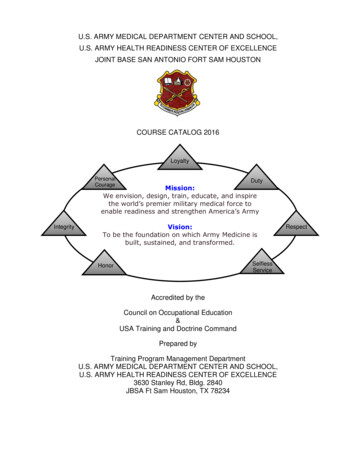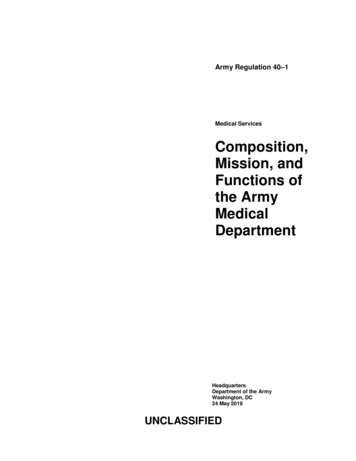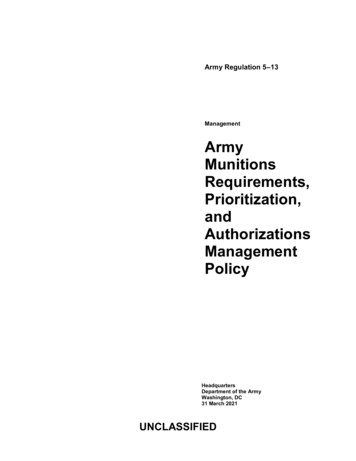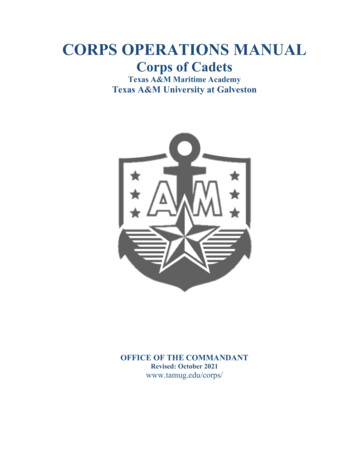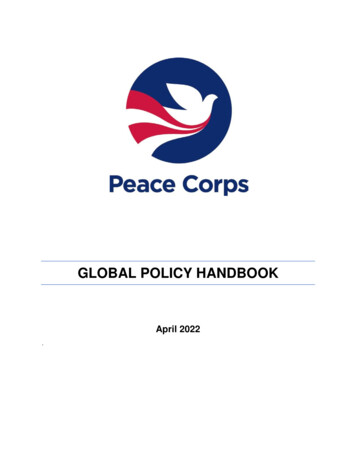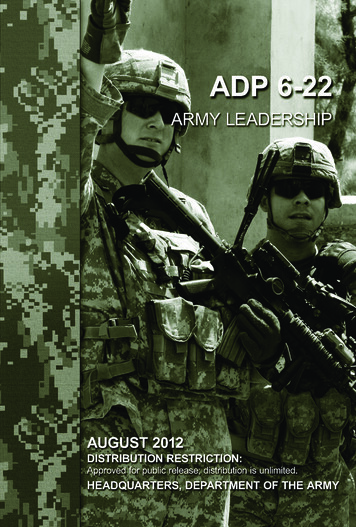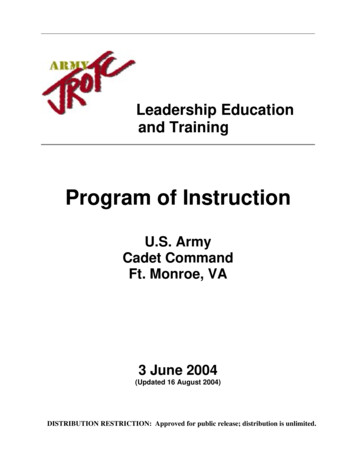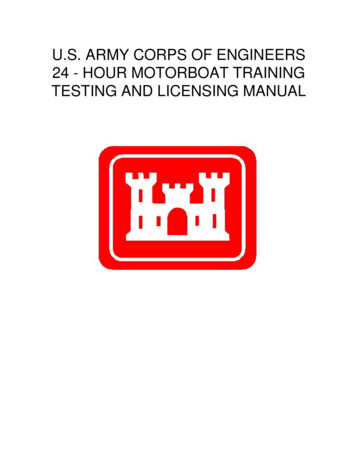
Transcription
U.S. ARMY CORPS OF ENGINEERS24 - HOUR MOTORBOAT TRAININGTESTING AND LICENSING MANUAL
U.S. Army Corps of Engineers 24-Hour MotorboatTraining Testing and Licensing ManualTable of ContentsActivityLocationCourse AgendaClassroomTabPolicy, Introduction and Safety Briefing Classroom1Boats/Personal Watercraftand Boat MaintenanceClassroom/Practical2Trailer and Trailer MaintenanceLaunching and RetrievingClassroom/Practical3Rules of the Road & Aids to Navigation Classroom4Required Safety EquipmentClassroom5Fire SuppressionClassroom/Practical6Emergency ProceduresPractical7Boat Orientation/MarlinspikeClassroom/Practical8Boat Operators Inspection ChecklistPractical9Course ManeuveringPractical10Towing and AnchoringPractical11Course EvaluationClassroom12
COURSE AGENDA24-hour Motorboat Operator Training ManualThe following agenda will be used by U.S. Army Corps of Engineers (USACE) totrain employee operators of boats/vessels less than 26 feet in length. It is notnecessary, but recommended, that course days run consecutively. The courseschedule can be altered to meet local requirements as long as the subjects listedbelow are included in the total curriculum.DAY 10800 Welcome, Introduction, Safety Briefing and Pretest0900 Required Safety Equipment1000 Change into Swimwear1015 PFD Swim, Land Based Rescue1130 Lunch1230 Boat and Boat Maintenance1315 Trailering/Trailer Maintenance1415 Rules of the Road & Aids to Navigation1515 Marlinespike1600 Fire Suppression1700 ENDDAY 20800 Trailering0900 Launching and Retrieving1000 Close Quarter Maneuvering and Docking1100 Lunch1200 Maneuvering Courses1500 Anchoring & Towing1600 Water Based Emergency Procedures1700 ENDDAY 30800 Trailering, Launching and Retrieving0900 Close Quarter Maneuvering and Docking1000 Maneuvering Courses1200 Lunch1300 Maneuvering Course Test1400 Pull Buoy Course and Recover Boats1500 Written Post Test/Marlinespike Test1630 Review/Questions1700 END
The following agenda allows students to travel to and from their duty stations the firstand last day of the trainingDAY 11230 Welcome, Introduction, Safety Briefing and Pretest1330 Required Safety Equipment1430 Boat and Boat Maintenance1530 Trailering/Trailer Maintenance1600 PFD Swim, Land Based Rescue1700 ENDDAY 20800 Rules of the Road & Aids to Navigation0900 Marlinespike0930 Fire Suppression1030 Trailering1130 Lunch1230 Launching and Retrieving1330 Close Quarter Maneuvering and Docking1430 Boat Handling Familiarization1530 Maneuvering Courses1700 ENDDAY 30800 Trailering, Launching and Retrieving0900 Close Quarter Maneuvering and Docking1000 Maneuvering Courses1200 Lunch1300 Anchoring & Towing1400 Water Based Emergency Procedures1500 Maneuvering Courses1700 ENDDAY 40800 Maneuvering Course Test0900 Pull Buoy Course and Recover Boats1000 Written Post Test/Marlinespike Test1130 Review/Questions1200 END
Tab 1 - Policy, Introduction and Safety Briefing24-hour Motorboat Operator Training ManualI.Introduction.A. ER 385-1-91 requires all U.S. Army Corps of Engineer (USACE) employees who operate USACE vesselsless than 26 feet long to complete a 24-hour Motorboat Operator Training course and be licensed prior to officialoperation of the USACE vessel.B. Purpose.1. To validate that Corps personnel operate boats in a safe and prudent manner and in accordance withrecognized Federal, state, local and USACE laws and standards.2. To validate the operation of boats at safe speed and that operators have the skills and knowledgenecessary to obtain and maintain their motorboat operator’s license.3. To validate that Corps motorboat operators know the proper rescue techniques, to include self-rescueand have the ability to swim 100 yards in a personal flotation device (PFD).II. Course Content. The class will cover:A. Activity Hazard Analysis with Risk Assessment Code.B. Required safety equipment.C. Boats and boat maintenance.D. Trailering and trailer maintenance.E. Rules of the Road and Aids to Navigation.F. Emergency procedures to include rescue, fire suppression, and towing.G. Docking and alongside maneuvers.H. Serpentine, Slalom, Star and Emergency Stop maneuvering courses.III. Course Safety.A. PFD’s will be worn at all times on or near the water (No Exceptions).B. In-water participation shall be voluntary for all students, but is a requirement for completing the course.C. Participants must pass a 100-yard swim test while wearing a PFD.D. Participants must be able to self-rescue themselves back into the boat.E. All vessels shall have on board all equipment required by U.S.Coast Guard, state, and EM 385-1-1.F. All boat operations will be done at a safe and controlled speed, under the direction of an instructor.G. There will be one instructor and one student onboard during the emergency stop maneuvering exercise.H. Engine kill switches will be tested prior to any boat operations getting underway.I. Engine kill switch lanyards will be worn at all times by boat operators when boats are underway.1-1
USACE Small Boating PolicyER 385-1-91, Training, Testing and Licensing of Small Boat Operators.Operators of USACE vessels, less than 26 feet in length, will successfully complete a 24-hourtraining class and be licensed prior to official operation of a USACE vessel. Licensed operatorswill complete an 8-hour refresher class every five years to retain the license.Motorboat License Examiners and operators will be trained to be fully knowledgeable ofprescribed safety procedures including the use of all equipment and/or tools necessary tosafely perform assigned tasks and be capable of swimming 100 yards with a PersonalFlotation device (PFD).EM 385-1-1, Safety and Health Requirements Manual01.A.15a. An Activity Hazard Analysis (AHA) shall be prepared and documented for eachUSACE activity as warranted by the hazards associated with that activity. Typically, an AHAshall be prepared for all field, laboratory, industrial and maintenance activities.01.A.15d. Work shall not begin until the AHA with Risk Assessment Code (RAC) for the workactivity has been discussed with all engaged in the activity in a job pre-brief.A sample AHA with RAC is included at the end of this tab. Districts must add any site specificinformation and hazards to the AHA for each training course. The AHA must be incorporatedas part of the training curriculum and reviewed daily during training to accommodate changingconditions or activities.19. F.05. All motorboat operators shall complete and document the following training:a. A boating safety course meeting the criteria of the United States Coast Guard Auxiliary,National Associationof Safe Boating Law Administrators (NASBLA), or equivalent;b. Motorboat handling training based on the type of boats they will operate, provided byqualified instructors (in-house or other). Operators must pass a written and operationaltest;c. Current United States Coast Guard (USCG) licensed personnel are exempt from theboating safety training, but they shall complete the written exam and operational test;d. Government employees shall complete a USACE-approved 24-hour initial boatingsafety course and refresher as prescribed in ER 385-1-91.1-2
Activity Hazard Analysis (AHA)Activity/Work Task: Boat Operators License Training CourseOverall Risk Assessment Code (RAC) (of the highest hazard):Risk Assessment Code (RAC) MatrixProbabilityProject Location:Contract Number:Date Prepared:SeverityPrepared by (Name/Title):Reviewed by (Name/Title):Notes: (Field Notes, Review Comments, LStep 1: Determine and enter RAC codes for each “Hazard” with safety “Controls” (E, H, M, or L)“Probability” is the likelihood to cause an incident, near miss, or accidentand identified as: Frequent, Likely, Occasional, Seldom or Unlikely.“Severity” is the outcome/degree if an incident, near miss, or accident didoccur and identified as: Catastrophic, Critical, Marginal, or NegligibleStep 2: Use the highest individual RAC of the Hazards Controls belowas the overall RAC for the Activity, and enter at the top of the AHA sheet.Job Steps1. Boat OperationsA) Maneuvering Courses(serpentine, slalom,emergency stop, star)MHazards1. Personnel2. Drowning3. Collisions4. Falls Overboard5. Fires/Explosions6. Sun/Heat7. Dehydration8. Eye Fatigue9. Dust/Debris/Material in Eye10. Damaged/Sinking Vessel11. Entanglement in LinesRAC ChartE Extremely High RiskH High RiskM Moderate RiskL Low RiskControls1. The emergency stop maneuvering course shall be conductedwith one instructor and one student on each vessel2. Wear Personal Flotation Device (PFD). Know location andproper use of lifesaving devices (throw ring, throw bag, reachpoles, ladder, cargo net)3. Follow and obey boating rules/laws, recognize aids tonavigation, maintain safe speeds, keep proper lookout4. Wear PFD, know proper rescue procedures and wear properfootwear to maintain balance and footing. Make sure kill switch isoperational and lanyard is attached to operator. Pay closeattention to all other boats operating on maneuvering courses.5. Follow proper venting and starting procedures. Know locationof fire extinguisher and proper suppression techniques.6. Wear proper clothing/hat to limit sun exposure. Use sunscreenand drink plenty of water.7. Rehydrate with water/Gatorade8. Wear proper eyewear/sunglasses9. Wear proper eye protection10. Obey navigation rules and heed weather warnings. Get tosafe harbor as soon as possible. Stay with vessel until rescue.Wear PFD.11. Keep vessel deck clear and properly coil or stow dock lines.Avoid pinch points and stay clear of lines under strain.RACLMLMLLLLLLL
12. Lacerations, Cuts, Punctures andAbrasions13. Bruises and Broken BonesB) Docking/AlongsideManeuvering1. Entanglement in Lines2. Pinch Points3. Falls2. Trailering/Launching Boats1. Trailering Vessels2. Launching/Retrieving Vessels3. Vehicle Operations1. Transportation2. Vehicle Enters the Water4. Refueling Boats1. General12. Inspect deck area and equipment for hazardous conditionsand correct before operating. Wear proper Personal Protectiveequipment (PPE). Have first aid kit readily accessible and knowproper first aid treatment.13. Keep steering wheel, throttle control and vessel interior as dryas possible. Maintain three point body contact with vessel.L1. Keep vessel deck clear and properly coil or stow dock lines.Avoid pinch points and stay clear of lines under strain.2. Deploy boat fenders. Keep all body parts inside vessel.3. Remain seated or in a stationary position until vessel isstopped. Maintain three points body contact with vessel.LLL1. Drive defensively. Obey traffic laws. Verify trailer is properlyconnected to tow vehicle and trailer lights are operational. Do noteat, drink, smoke, use cell phone or perform other tasks thatinterfere with attention to driving.2. Make sure boat ramp is clear of obstructions and make note oframp conditions (wet, algae, etc.). Engage 4-wheel drive ifnecessary. Lower driver’s side window, remove seat belt and turnoff radio. Prepare the vessel in staging area. Use a spotter whenavailable to back down ramp. Set parking brake when trailer islowered to proper launch depth. Start vessel engine beforedisconnecting winch strap being aware of strap tension, pinchpoints and winch handle. Maintain communication with vehicleoperator as well as boat operator understanding signals given.L1. Drive defensively. Obey traffic laws. Perform walk around ofvehicle prior to driving and make sure all lights are operational.Check fluid levels, condition of tires and perform preventativemaintenance as needed. Do not eat, drink, smoke, use cellphone or perform other tasks that interfere with attention todriving.2. Stay calm, unfasten seat belt and lower window(s) to equalizepressure and offer an escape route. Use automatic center punchto break window if necessary.1. a) Before fueling: close all compartments, hatches. Turn offelectrical system and extinguish any open flames. No smoking.Remove portable fuel tanks from boatb) During fueling: maintain a ground between the fuel nozzleand the gas tank. Fill slowly to avoid spillage. Do not fill tank tobrim. Leave room for fuel to expandc) After fueling: Replace fuel cap tightly, open allcompartments, hatches. If equipped, run blower motor for fourminutes to vent bilgeLLLLL
5. Using Auto Inflatable PFD’s1. General2. PFD Worn Improperly or ImproperlyAssembled3. PFD damaged from storage4. Drowning6. Using PFD’s1. General1. Employees must be 16 years of age and weigh at least 90lbsto wear this PFD. Employee must have water tested PFD prior toeveryday use and must be trained in the use, maintenance, care,storage and inspection as per manufacturer’s instructions.2. Employees must follow manufacturer’s instructions for wearingand properly installing re-charge kit. Verify indicator gauge reads“green”.3. PFD must be thoroughly inspected by disassembling PFD andmanually inflating bladder to check its integrity. Inspect armingmechanism for damage. Any deficiencies must be correctedbefore the PFD can be put back in service.4. Employees wearing this PFD must have basic ability to treadwater and be physically able to swim. Employee must be trainedin the manual operation of this PFD should automatic inflationfail.1. Before use make sure PFD is in serviceable condition and isnot ripped or torn and all buckles, zippers or other fasteners areworking properly. Make sure PFD is the right size and type for thetask at hand and fits snugly.7. Self-Rescue1. General1. Employees must demonstrate ability to self-rescue themselvesback into the vessel by one of four methods:a. Cavitation Plate on vessel engineb. Chin bouncec. Stirrupd. Ladder8. Victim Rescue1. General1. Employees must demonstrate ability to rescue a consciousand unconscious victim back to the vessel:A. Conscious Victim – use rescue procedure of TalkReach-Throw-Go and elevate procedure to the properstep depending on circumstances.B. Unconscious Victim – use any means (throw ring,cargo net, dock lines, reach pole, etc. to get victim astrideof the boat. If possible retrieve victim back into boat. Ifnot possible secure victim astride vessel until helparrives.9. Classroom Work1. Eye Strain2. Tripping/ Slipping3. Electrical Shock4. Office Machinery1. Provide proper lighting2. Maintain good housekeeping. Secure any loose cords to floor.3. Proper grounding and maintenance of equipment. Repair orreplace any damaged cords, switches, etc. or remove fromservice.4. Heed and obey caution signs on machinery. Prevent jewelry,loose clothing and hair from getting caught in machine.LLLMLLMLLLL
10. ReservedEquipment to be UsedInspection Requirements1. Motorboats less than 26’ in length withoutboard engines.2. Corresponding trailer matched to themotorboat.3. Pick-up trucks4. Safety rescue devices such as throw rings,throw bags, reach poles, ladders, cargo netand lines, first aid kit.5. Classroom equipment to include:computers, projector and copy machine.1. Small Boat and Equipment Checklist fromER 385-1-912. Small Boat and Equipment Checklist fromER 385-1-913. Small Boat and Equipment Checklist fromER 385-1-914 & 5 Requirements vary to each particular pieceof equipment as outlined in US Army Corps ofEngineers Safety Manual EM 385-1-1 or as permanufacturer’s instructionsTraining Requirements& Competent or Qualified Personnel name(s)Employees participating in this training must:A. Have completed a NASBLA or equivalent boaterssafety education courseB. Be able to swim 100 yards with a PFDC. Be able to self-rescue themselves back into thevessel.D. Pass the written exam with a minimum score of 80%E. Be tethered to the kill switch via a lanyard whenoperating the vesselF. Wear a Type III or better inherently buoyant PFDG. Demonstrate the ability to handle the boat andoperate correctly through the maneuvering coursesH. Be able to trailer, launch and retrieve the boatI. Demonstrate the ability to correctly dock the boatJ. Closed toed and closed heeled shoes will be wornduring entire training including all water exercisesBoat License Examiners:A. A minimum of two examiners are required to performthe 24 hour motorboat training courseB. Must be trained and certified in CPR/First Aid/AEDC. Option to use a second lanyard attached to thestudents kill switch lanyard when student is operating thevesselQualified Examiners:
Tab 2 - Boats/Personal Watercraft and Boat Maintenance24-hour Motorboat Operator Training ManualI. Introduction: Provide a general introduction to the parts of boat and motor.II. Hull.A. Hulls are made of many different materials, which have distinct advantages and disadvantages.1. Aluminum – these hulls are lightweight, but noisy and rough riding.2. Fiberglass – these hulls are strong, light, relatively inexpensive, but are difficult to repair.3. Steel – these hulls are strong, but very heavy. Steel hulls make for a slow boat.4. Inflatable – these hulls are portable, but easily damaged.5. Other types include wood, concrete, and synthetic fibers.2-1
B. Types of hulls.1. Displacement hulls move through the water. These hulls are slow but very stable. Boatswith displacement hulls are designed to cut through the water with a minimum of propulsion. Mostsailboats and large cruisers have displacement hulls to allow them to travel more smoothly throughthe water.2. Planing hulls move on top of the water. These hulls are fast but less stable than adisplacement hull. Boats with planing hulls are designed to rise up and glide on top of the water whenenough power is supplied. Most small powerboats, including personal watercraft (PWC) have planinghulls allowing them to travel more rapidly across the water.C. Hull shapes.1. Flat Bottom. Flat bottom boats are typically small open boats such as johnboats. Flatbottomed boats can easily get "on plane" or ride on top of the water at high speeds. Flat bottom boatsare typically intended for use on calm waters such as ponds, small lakes, and slow rivers becausethey do not handle well in choppy or rough water, especially at planing speeds. Flat-bottomed boatsare not very stable; caution should be used when moving around them.2. Round Bottom. Round bottom boats almost "glide" through the water. Because roundbottomed boats are very efficient at moving through water, most cruising sail and powerboats haverounded hulls. Typically, round-hulled boats move at slow speeds.3. Deep-V hull. "V-hulls" are designed to operate at high speeds and to "cut" through roughwater. V-hulls are not as efficient as flat or round-bottomed boats, and need larger engines to moveat similar speeds.4. Cathedral hull. Cathedral or multi-hulls, are two or more hulls attached together. Thiscombination of hulls allows for much more stability than what is found in other hull forms. The airpocket that is formed between the hulls may also provide lift, helping the boat get on plane moreeasily and increasing efficiency.D. Maintenance.1. The bottom of the boat must be kept clean to maximize the performance of the boat. A dirtyhull will reduce speed and use excessive fuel.2. All joints and seams in the hull should be checked regularly for cracks, signs of wear andleaks. The bilge should also be checked.2-2
III. Engine (motor). Do not overpower your vessel by using a motor with a horsepower rating higherthan the maximum stated on the boat’s capacity plate.A. Types of motors.1. Inboard motors are mounted inside the hull's midsection or in front of the transom. Aninboard on a boat is a four-stroke automotive engine adapted for marine use. The engine turns adrive shaft that runs through the bottom of the hull and is attached to a propeller at the other end.Steering of most inboard boats is controlled by a rudder behind the propeller.2. Outboard motors are a complete power unit, including an engine, gear case and propeller,mounted on the transom of the boat. Outboards range in size from under one horsepower (hp) tomore than 300 hp. Outboards include electric trolling motors. Outboards have a higher horsepowerto-weight ratio than other engine types. Most outboards have separate fuel tanks that are eitherportable or built into the boat, although smaller motors have self-contained fuel tanks. Outboards areinternal combustion engines. A growing number of outboard engines are of four-stroke design; butmost are still 2-stroke engines, which require oil to be mixed with the fuel to properly lubricate theengine. Steering of outboard boats is controlled by a tiller steering wheel, which swivels the entireengine to direct propeller thrust.3. Inboard/Outboard (I/O) motors combine features found on both inboard and outboardengines. Stern drive motors are mounted inside the boat and attached through the transom to a driveunit, which resembles the lower section of an outboard. Stern drives are four-stroke automotiveengines adapted for marine use. The engine turns a drive shaft that runs through the transom and isattached to a propeller at the other end. Steering is controlled by a drive unit that swivels like anoutboard.4. Jet Drive systems have the advantage of having no propeller to cause potential danger topeople in the water and marine life. They are usually inboard engines that take in water, which flowsthrough a pump powered by an impeller. The water is then discharged at high pressure through anozzle that propels the boat forward. The nozzle swivels to provide steering to the boat. Mostpersonal watercraft use jet drives.2-3
B. Fuel.1. 4-Cycle engines use straight gasoline and have a separate oil reservoir, which should bechecked regularly.2. 2- Cycle engines utilize a mixture of gasoline and oil, i.e. 100:1 [1% oil] or 50:1 [2% oil].Outboards are typically 2-Cycle engines though 4-Cycle engines are gaining popularity.3. If your vessel has a permanently installed fuel tank, pour lubricant (oil) into tank withgasoline as the tank is filled.4. Safety Warning: Gasoline is extremely flammable and highly explosive under certainconditions.a. Always mix fuel outdoors, never indoors.b. Never smoke or allow open flames or sparks nearby when mixing or refueling.c. Always stop motor before refueling.d. Remove portable tanks from boat when refueling.C. Propeller. Boat motor and propeller match-up is important for proper operation.1. Plastic propellers (props) are used in low horsepower situations. The blades tend to cupwhen operating. These props are less expensive than props made of other materials.2. Aluminum props are standard equipment on many engines. They have good strength andcorrosion resistance. Aluminum props can chip or bend if it strikes a submerged object. This bendingor chipping can save drive components of the engine.3. Stainless Steel props are the strongest, most effective props available. Stainless steelpropellers are the most expensive props on the market. They are very good for use in deep water.This prop won’t bend if it strikes an object, but this may transfer damage to other drive components ofthe engine.4. The number stamped on the prop refers to the prop’s diameter and pitch. Example:numbers 13x10 mean the prop has a 13-inch diameter and a 10-inchpitch.a. Diameter is the distance across the circle described by theblade. As a rule, a slower turning, larger diameter propeller is moreefficient than a faster turning, small diameter propeller.b. Pitch is a product of the propeller’s diameter and the rakeof its blades and is the distance in inches the prop should travelforward in one revolution.2-4
5. Boat/Prop Match up.a. Find the recommended wide-open throttle (WOT) rpmrange for your motor in your owner’s manual.b. Make several test runs to determine the maximum rpmand boat speed.c. If the WOT rpm is too high; install the next larger pitch and retest.d. If the WOT rpm is too low; install the next smaller pitch and retest.D. Routine motor maintenance. (Check owner’s manual and shop manual for detailedprocedures).1. Grease all fittings and drive parts of the motor with proper lubricants.2. Change lower unit (gear case) lubricants at least every 100 hours of operation or once eachseason, whichever occurs first.3. Inspect spark plugs and clean or replace as necessary.4. Check motor for loose hose connections, leaks or parts lying inside lower housing tray.5. Propeller examination and replacement/installation. (Instructor should demonstrate how tochange a propeller)a. Remove and clean propeller if you find fish line wrapped around the shaft.b. Replace propeller if damaged by being bent or a series of nicks is present. Theunbalanced propeller could damage the engine.E. Trouble Shooting.1. Engine fails to start or engine loses power or stops while under way. (Engines are morelikely not to start than to quit while running)a. Out of gas, gas is old, or the fuel system is dirty.b. Check the valves of a portable fuel tank and the fuel line from the tank to the engine. Besure the line is properly connected to the tank and to the engine.c. Check the battery connections.d. Loose wire in the ignition circuit. Warning: The ignition system on an outboard systemcan cause a serious shock.e. Fuel not reaching cylinders. Check the on/off valve and the fuel from the tank to thecylinders; check the fuel line under the engine cover; check the spark plugs to see if they are wet withfuel; if so, the engine may be flooded.f. Overheated. If the engine is hot, the cooling system may be blocked or the water pumpmay be worn out. Do not try to start an overheated engine, let it cool first. Outboard engines havewater pump indicators that discharge a steady stream of water when the water pump is operatingproperly.2-5
g. Fouled spark plug – clean or replace the spark plug.h. Carburetor adjustment too lean or too rich.i. Improper oil/fuel mixture.j. Kill switch is disengaged.2. Engine seems to run well but lacks power while under way:a. Improper mounting.b. Incorrect tilt angle or improper load distribution.c. Fouled propeller or lower unit.d. Damaged propeller blades or bushing assembly.e. Engine knock. Often caused by loose propeller or loose flywheel nut, by worn bearings,worn pistons, or by a broken engine mount spring. Generally, if the engine starts to knock, take it to adealer.f. Excessive water in bilge resulting in extra weight. Check for leak or drain plug.2-6
Personal Watercraft (PWC)I.IntroductionA PWC is a small watercraft that uses an inboard jet drive as propulsion and is designed to beoperated by sitting, standing or kneeling on rather than inside the vessel. The United StatesCoast Guard (USCG) includes personal watercraft in the group of inboard vessels less than 16feet in length.II.RequirementsPWCs are subject to all of the same laws and requirements of any other vessel plus thefollowing specific laws.I. Each person riding on or being towed behind a PWC must wear a USCGapproved Type I, II, III or V personal flotation device (PFD). It is advised that thePFD be approved for impact at high speeds.II. PWCs must be equipped with a fully operational self-circling device or a lanyardtype ignition safety switch. The lanyard must be attached to the person, clothingor PFD of the operator.III. PWCs may not operate between sunset and sunrise.IV. PWCs must be operated at idle speed within certain distance of persons in thewater, a non-moving vessel, a bridge and a dock or pier.V. It is illegal to jump the wake of another vessel unnecessarily close to the othervessel or when visibility around the other vessel is restricted.VI. It is illegal to chase, harass or disturb wildlife.III.Operationa. PWCs are propelled by a jet drive where water is forced out under pressure through asteering nozzle. This jet of water is directed by the steering control.b. The most important thing to remember is that you must always have power in order tomaintain control. Some newer models have steering control at idle but be familiar with themodel you are operating.c. Always allow plenty of room for stopping. Even models with a braking system do not stopimmediately. Plan your escape and give plenty of space between you and other vessels.d. A passenger on a PWC should never be seated in front of the operator.e. Make sure the water is at least 30 inches deep to prevent damage to the jet drive anddamage to the environment.f. Know how to re-board your PWC if you fall off and know how to upright an overturned PWC.There are specific direction on how to roll a PWC as to not cause damage to internal parts.It is a good idea to practice this situation before and emergency.g. PWCs are very maneuverable and because of that can get into trouble fast. Always beaware of your surroundings and look over both shoulders before making turns.h. Read the operation manual of your PWC and become familiar with maintenance andoperation before use. Pay particular attention to the electrical system to ensure there is nopotential for electrical spark. Gas fumes can collect in the engine compartment and anexplosion from the spark could occur.2-7
Tab 3 - Trailering, Trailer Maintenance & Launching/Retrieving24-hour Motorboat Operator Training ManualI. Introduction. This module will provide a general introduction into trailer characteristics, trailermaintenance, safe towing and launching and retrieving. Choosing the correct trailer for the jobrequires knowing the load rating, load height, and what equipment is on the trailerA. Load rating.1. Check the manufacturer’s specifications, which are on a plate attached to the trailer. Ifthe weight of the boat and its engine is more than 90% of the recommended load capacity, buy thenext larger trailer. This is because your gear (fuel, PFD’s, anchors, lines, etc.) will increase theoverall weight by at least 10%.2. Trailers are classified by the maximum amount they may weigh when fully loaded.Gross Vehicle Weight RatingClass 1 - 2000 lbs.Class 2 - 2001 to 3500 lbs.Class 3 - 3501 to 5000 lbs.Class 4 - 5000 lbs.B. Load height. Ensure that the boat is properly loaded onto th
01.A.15a. An Activity Hazard Analysis (AHA) shall be prepared and documented for each USACE activity as warranted by the hazards associated with that activity. Typically, an AHA shall be prepared for all field, laboratory, industrial and maintenance activities. 01.A.15d. Work shall not begin
